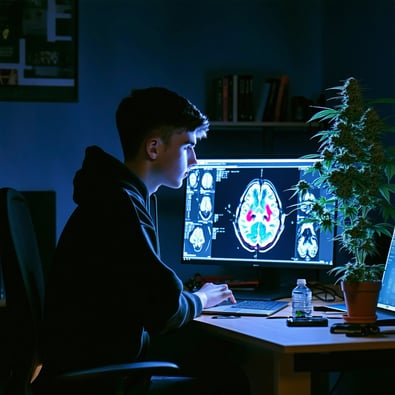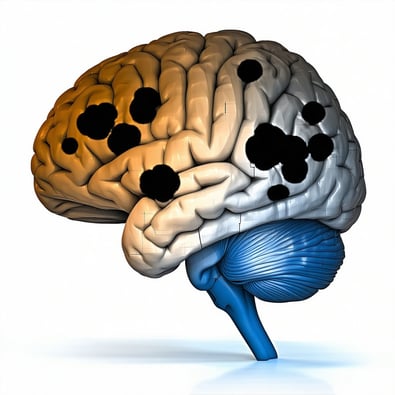Perhaps the most famous psychoactive drugs substances that alter psychological and physiological function - are cannabis and psychedelics.
When used, these drugs have both detrimental and beneficial outcomes that impact everyday life.
For example, cannabis (also known as marijuana) could be used as a therapeutic option for a variety of neurological disorders like Parkinson’s, Alzheimer’s, and even brain cancer when administered properly. On the other hand, cannabis and other psychoactive drugs can be used recreationally and can be linked to problems regarding cognitive functioning, mood, and other symptoms.
Naturally occurring compounds found in the Cannabis plant, called cannabinoids, are responsible for the psychological and physiological symptoms of the drug. Commonly recognized cannabinoids include cannabidiol (CBD), cannabigerol (CBG), and tetrahydrocannabinol (THC). THC is mostly responsible for the symptom described as “high” by cannabis users - a state of altered memory, movements, thinking, time perception, and coordination often associated with pleasure receptors in the brain, making it a popular illicit drug. CBD and CBG do not induce a psychoactive “high,” but rather influence appetite, pain perception, and memory, with their uses being primarily reduction of anxiety and inflammation and treating diseases like multiple sclerosis.
However, innovating common techniques to perform analysis of psychoactive drugs, such as gas chromatography, liquid chromatography, and mass spectrometry, can help to address some of the regulatory and therapeutic challenges associated with this substance.
Due to its both addictive and curative potential, cannabis is a hot topic within the legal and medical industries. As one of the main tracks at this year’s Pittcon, researchers will outline several studies that have analyzed and characterized cannabis and psychoactive substances. These presentations will be key to helping advance innovation in the field of cannabis and psychedelics, helping better craft solutions to reduce the improper use of these drugs as well as create potential medicines.
The Challenge of Regulating Cannabinoids
With the increased legalization of cannabis in various countries around the world, there has been a rise in products, including cannabinoids like CBD, CBG, and THC, that are now commercially available for both recreational and medical use. THC can be ingested in the body via inhalation of marijuana smoke or orally as edibles, with cannabinoids existing in the form of candy or baked goods. Products containing CBD and CBG include oils that can be ingested, such as dietary supplements, or applied to the skin in products such as lotions. However, due to this multiplicity, there is now a need to diversify public health policies to keep up with the fast-paced cannabinoid market.
As different cannabinoids have different legal statuses in different parts of the world, these seemingly everyday products are hard to regulate. Thus, more scientific evidence is needed to assess the safety and efficacy of cannabinoids to make informed decisions about medicinal products, health benefits, and public health policy. These vital topics will be discussed at this year’s Pittcon.
Analyzing Natural and Synthetic Cannabinoids for Pharmaceutical and Regulatory Purposes
Limitations of traditional analytical techniques when studying cannabis include long experiments, lack of specificity, and complex data analysis. Yet, these challenges can be resolved with mass spectrometry techniques. Benedetta Garosi, a doctoral researcher and graduate research assistant at the University at Albany, SUNY, New York, will be hosting a talk on this issue; “High-end Sweets - Application of Ambient Mass Spectrometry for the Forensic Analysis of Cannabinoid-infused Complex Matrices.”
This study used direct analysis in real-time – high-resolution mass spectrometry (DART-HRMS) – to rapidly analyze the three different cannabinoids in edibles - CBD, CBG, and THC. Using this technique, Garosi and her team were able to accurately and precisely distinguish between the cannabinoids in edibles. As a result, DART-HRMS holds great promise for use in forensic cases and in helping medical professionals make informed health decisions.
Synthesized cannabinoids are synthetic or manmade chemicals that imitate the effects of marijuana but are less understood, less predictable, and more dangerous as an ingredient than natural cannabinoids. Sometimes, sellers of cannabis-based products will incorporate synthetic cannabinoids into goods because it is less expensive, quicker, and easier to manufacture. However, this practice poses a danger to consumers as contamination and compromised quality of a product are likely. Furthermore, synthetic cannabinoids are difficult to regulate and can cause harmful symptoms when.
As presented by Kevin Lester from Virginia Commonwealth University, another Pittcon talk entitled “Suspicious Δ8-THC products Analyzed by (DART-MS), Liquid Chromatography Mass Spectrometry (LC-MSMS),(GC-MS), (HS-GC-MS), Microbiological Ana, and Microscopy” will summarize synthesized THC and the safety of products, including its use as an ingredient. Using DART-MS in combination with liquid chromatography-mass spectrometry (LC-MS), gas chromatography-mass spectrometry (GC-MS), and microscopy methods, Lester and his team were able to successfully characterize and identify the number of synthesized cannabinoids found in the goods being tested.
Quickly, effectively, and accurately identifying and quantifying both natural and synthetic cannabinoids will be a huge step toward formulating regulatory policy and implementing health interventions, and the development of cutting-edge medicines will be a major part of this. Thus, further work must be carried out on the effects of cannabinoids and their biochemistry. Pittcon is at the forefront of this, contributing to the frontier of psychoactive drug research.
To this end, Pittcon will be host to leading life science and biotech companies, including DigiVac, GenTech, and PerkinElmer.
Pittcon Drives Forward Cannabis and Psychedelics Research
Cannabis and psychedelics pose critical challenges to the pharmaceutical and policymaking worlds and require innovative studies – such as the ones described above – to help people overcome and handle these drugs in beneficial ways to everyday life. This year at Pittcon, scientists and industry experts will spotlight the methodologies and technologies used in various processes to identify and quantify levels of cannabinoids as well as assess cannabinoid product quality on the illegal and commercial markets.
From using mass spectrometry to characterize cannabis to the regulatory challenges of synthesized cannabinoids, experts will collaborate to innovate novel solutions to some of the challenges posed by psychoactive drugs, demonstrating the future feasibility of cannabis and psychedelics in society. Visit the Pittcon website to learn more about the current progress and future potential for cannabis and psychedelics research.




